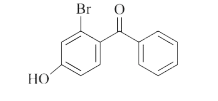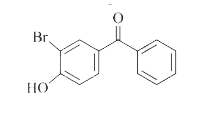p-Hydroxybenzophenone upon reaction with bromine in carbon tetrachloride gives:




The correct Answer is:D
To solve the problem of what p-hydroxybenzophenone gives upon reaction with bromine in carbon tetrachloride, we can follow these steps:
Step 1: Understand the Structure of p-Hydroxybenzophenone
- p-Hydroxybenzophenone consists of two benzene rings connected by a carbonyl (C=O) group. One of the benzene rings has a hydroxyl (-OH) group at the para position relative to the carbonyl group.
Step 2: Identify the Electrophilic Substitution Reaction
- The presence of the hydroxyl group (-OH) on the benzene ring activates the ring towards electrophilic substitution due to its +M (mesomeric) effect. This means that the -OH group can donate electron density to the benzene ring, making it more reactive towards electrophiles like bromine.
Step 3: Determine the Position of Bromine Substitution
- In electrophilic aromatic substitution reactions, the bromine will preferentially substitute at the ortho or para positions relative to the -OH group. Since the -OH group is at the para position, the bromine can attack either the ortho or para positions. However, steric hindrance will favor the ortho position for substitution.
Step 4: Draw the Product Structure
- After the bromine reacts with the ortho position of the benzene ring, the product will have a bromine atom attached to the ortho position of the benzene ring that is already substituted with the -OH group. The carbonyl group remains unchanged.
Step 5: Write the Final Product
- The final product can be represented as follows:
- The structure will still contain the two benzene rings, the carbonyl group (C=O), and now a bromine atom attached to the ortho position of the benzene ring with the -OH group.
Final Answer
The product of the reaction of p-hydroxybenzophenone with bromine in carbon tetrachloride is 2-bromo-p-hydroxybenzophenone.
---
- p-Hydroxybenzophenone consists of two benzene rings connected by a carbonyl (C=O) group. One of the benzene rings has a hydroxyl (-OH) group at the para position relative to the carbonyl group.
- The presence of the hydroxyl group (-OH) on the benzene ring activates the ring towards electrophilic substitution due to its +M (mesomeric) effect. This means that the -OH group can donate electron density to the benzene ring, making it more reactive towards electrophiles like bromine.
- In electrophilic aromatic substitution reactions, the bromine will preferentially substitute at the ortho or para positions relative to the -OH group. Since the -OH group is at the para position, the bromine can attack either the ortho or para positions. However, steric hindrance will favor the ortho position for substitution.
- After the bromine reacts with the ortho position of the benzene ring, the product will have a bromine atom attached to the ortho position of the benzene ring that is already substituted with the -OH group. The carbonyl group remains unchanged.
- The final product can be represented as follows:
- The structure will still contain the two benzene rings, the carbonyl group (C=O), and now a bromine atom attached to the ortho position of the benzene ring with the -OH group.
The product of the reaction of p-hydroxybenzophenone with bromine in carbon tetrachloride is 2-bromo-p-hydroxybenzophenone.
Topper's Solved these Questions
- HYDROCARBONSBOOK - VMC MODULES ENGLISHCHAPTER - HYDROCARBONSEXERCISE - JEE Advanced Archive
121 Videos
- HYDROCARBONSBOOK - VMC MODULES ENGLISHCHAPTER - HYDROCARBONSEXERCISE - Level-2 (Numerical Value Type)
15 Videos
- HALOALKANES AND HALOARENESBOOK - VMC MODULES ENGLISHCHAPTER - HALOALKANES AND HALOARENESEXERCISE - IN-CHAPTER EXERCISE - F
6 Videos
- ICONIC EQUILIBRIUMBOOK - VMC MODULES ENGLISHCHAPTER - ICONIC EQUILIBRIUMEXERCISE - IMPECCABLE
50 Videos
Similar Questions
Knowledge Check
The bond in Carbon Tetrachloride is
ASingle Covalent BondBDouble Covalent BondCIonic bondDTriple Covalent BondWhich type of bond is present in carbon tetrachloride ?
AIonic bondBCovalent bondCCoordinate bondDNone of these
Conversion of Carbon disulphide into carbon tetrachloride
View SolutionPhenol reacts with bromine in carbon disulphide at low temperature to give
View SolutionPhenol reacts with bromine in carbon disulphide at low temperature to give
View SolutionFind the mean free path of phonons in carbon tetrachloride.
View SolutionCalculate the molar mass of Carbon tetrachloride
View SolutionWhat would you see when ethyne is bubbled through a solution of bromine in carbon tetrachloride?
View Solution
